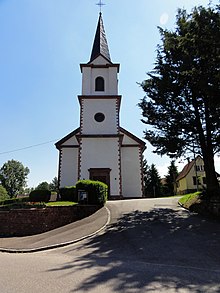Gumbrechtshoffen
| Gumbrechtshoffen | ||
|---|---|---|

|
|
|
| region | Grand Est | |
| Department | Bas-Rhin | |
| Arrondissement | Haguenau-Wissembourg | |
| Canton | Reichshoffen | |
| Community association | Pays de Niederbronn-les-Bains | |
| Coordinates | 48 ° 54 ' N , 7 ° 38' E | |
| height | 167-271 m | |
| surface | 5.74 km 2 | |
| Residents | 1,175 (January 1, 2017) | |
| Population density | 205 inhabitants / km 2 | |
| Post Code | 67110 | |
| INSEE code | 67174 | |
 Mairie Gumbrechtshoffen |
||
Gumbrechtshoffen ( German : Gumprechtshofen , Alsatian Gumbertshoffe ) is a French commune with 1,175 inhabitants (as of January 1, 2017) in the Bas-Rhin department in the Grand Est region (until 2015 Alsace ).
geography
Gumbrechtshoffen lies at an altitude of 180 meters above sea level on the Northern Zinsel .
history
middle Ages
The oldest surviving mention of the place is from 1109. The Lordship of Lichtenberg bought the village of Gumbrechtshofen in 1332 from the Counts of Ötingen . Henry III. von Lichtenberg and his son, Konrad II, had to sell or pledge a number of properties to their relative, Simunt von Zweibrücken-Bitsch , in 1374 . Among them was the village of Gumbrechtshofen. Ultimately, this resulted in the village being administered as a condominium , in which the Counts of Zweibrücken-Bitsch and their legal successors as well as the Lords of Lichtenberg and their legal successors each owned half of the village.
The condominate
The Lichtenberg share was assigned to the Pfaffenhofen office. Anna von Lichtenberg (* 1442; † 1474), one of the two heirlooms of Ludwig V von Lichtenberg (* 1417; † 1474) married Count Philip I the Elder of Hanau-Babenhausen (* 1417; † 1480), one of them had received a small secondary school from the inventory of the County of Hanau in order to be able to get married. The county of Hanau-Lichtenberg came into being through the marriage . After the death of the last Lichtenberger, Jakob von Lichtenberg , an uncle of Anna, Philipp I. d. Ä. 1480 half of the Lichtenberg rule . The Pfaffenhofen office with the Lichtenberger share in Gumbrechtshofen also belonged to this half.
On the Zweibrücken-Bitsch side, his share in the village of Gumbrechtshofen belonged to the Oberbronn rule . The rule of Oberbronn has been documented since the 13th century and belonged one after the other to a number of noble families. These initially included the Lords of Ochsenstein . From them the Counts of Zweibrücken-Bitsch inherited the rule of Oberbronn in 1485, to which they added their share of Gumbrechtshofen. The rule of Oberbonn - and with it Gumbrechtshofen - came from Zweibrücken-Bitsch to this family in 1551 as a dowry on the occasion of the marriage of Amelie von Zweibrücken-Bitsch to Philip I of Leiningen-Westerburg . As a successor to the Leininger, the Landgraves of Hessen-Homburg and, to a lesser extent, the Swedish aristocratic family of the Barons von Sinclair became lords of Oberbronn in the 17th century.
French suzerainty
As a result of France's reunification policy in the second half of the 17th century, the office of Pfaffenhofen and the rule of Oberbronn, and thus the entire village of Gumbrechtshofen, fell under the sovereignty of France . In 1709 the condominium was dissolved: Gumprechtshofen came to Hessen-Homburg as a whole and thus left the County of Hanau-Lichtenberg. The Hesse-Homburg part passed to the Hohenlohe-Waldenburg-Bartenstein family in the middle of the 18th century , while the Sinclair part went to the von Lewenhaupt family, who were also of Swedish origin .
Modern times
Hohenlohe had to cede the rule of Oberbronn to France in 1793 and was later resigned to areas of the secularized diocese of Würzburg . In the administrative reforms due to the French Revolution , the rule of Oberbronn was dissolved.
Up until 1945 there were two independent towns, Ober- and Niedergumbrechtshoffen, which were merged on September 1, 1945.
Population development
| year | 1962 | 1968 | 1975 | 1982 | 1990 | 1999 | 2006 | 2017 |
| Residents | 1091 | 1092 | 1063 | 1098 | 1186 | 1226 | 1227 | 1175 |
| Sources: Cassini and INSEE | ||||||||
Attractions
literature
- Fritz Eyer: The territory of the Lords of Lichtenberg 1202-1480. Investigations into the property, the rule and the politics of domestic power of a noble family from the Upper Rhine . In: Writings of the Erwin von Steinbach Foundation . 2nd edition, unchanged in the text, by an introduction extended reprint of the Strasbourg edition, Rhenus-Verlag, 1938. Volume 10 . Pfaehler, Bad Neustadt an der Saale 1985, ISBN 3-922923-31-3 (268 pages).
- Friedrich Knöpp: Territorial holdings of the County of Hanau-Lichtenberg in Hesse-Darmstadt . [typewritten] Darmstadt 1962. [Available in the Hessisches Staatsarchiv Darmstadt , signature: N 282/6].
- Alfred Matt: Bailliages, prévôté et fiefs ayant fait partie de la Seigneurie de Lichtenberg, du Comté de Hanau-Lichtenberg, du Landgraviat de Hesse-Darmstadt . In: Société d'Histoire et d'Archaeologie de Saverne et Environs (Eds.): Cinquième centenaire de la création du Comté de Hanau-Lichtenberg 1480 - 1980 = Pays d'Alsace 111/112 (2, 3/1980), p 7-9.
- Le Patrimoine des Communes du Bas-Rhin . Flohic Editions, Volume 2, Charenton-le-Pont 1999, ISBN 2-84234-055-8 , pp. 870-871.
Web links
Individual evidence
- ↑ Eyer, p. 61.
- ↑ Eyer, pp. 92, 94.
- ↑ Eyer, p. 238.
- ^ Weber, p. 37, note 59.
- ↑ Knöpp, p. 14; Matt, p. 7, state that the condominium was dissolved in favor of Leiningen, but Hessen-Homburg had already taken over the inheritance here.
- ↑ Waltz and Rudolph.
- ^ Gerhard Köbler : Historical Lexicon of the German Lands. The German territories from the Middle Ages to the present. 7th, completely revised edition. CH Beck, Munich 2007, ISBN 978-3-406-54986-1 , p. 481: Keyword: Oberbronn (Herrschaft).


